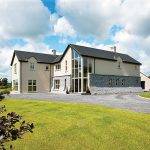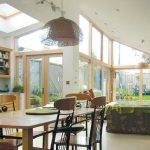Float ready plaster is a pre-mixed ready to use mortar which will keep on site for 12 hours or, if delivered in the evening, will retain its properties for the following morning. It is applied over the scratch coat, although it can and is sometimes used for the scratch coat, depending on the sand grading. Note that you may have to ask for, (or add it yourself), a waterproofing agent to be included if large external areas are to be covered.
Alternatively there is dry mix mortar which can be formulated to your own recipe, inclusive of waterproofers, retarders and pigment colours. The 16 ton silo when it arrives on site requires an area of sound, flat ground, usually 3 phase power and potable water. Whilst it is still required practice to use two coats with this, manufacturers can be licensed to use only one coat onto the scud coat, or even rough block work. Special formulations can be machine applied or trowelled on.
A third option is a lime based soft coat called a buttercoat, which has stone chippings thrown on the fresh render to create a dry dash finish. This has the advantages of remaining softer thus providing a longer working time, and can be coloured. It is applied with a trowel.
Curing The newly rendered surface must be prevented from drying out too rapidly. Spraying with water and protection from the sun or wind may only be necessary in hot and dry weather. In contrast, spatterdash (a light keying coat), should be wetted down an hour or so after application to ensure adequate hydration.
It’s very important that each coat should be allowed to shrink and dry out as long as possible, at least for some days, before the next coat is applied. The length of time will depend on the weather and air temperature; slower in winter, quicker in summer. Protection of coloured render in poor weather is particularly important to prevent streaking and discolouration.
Crazing This happens when there is unequal shrinkage of the surface compared to what lies below. Although the cracks are narrow and mainly on the surface, they could develop deeper fissures. Cement rich, steel trowelled finishes are particularly liable to craze, leaner mixes with a scraped, textured or other rough finish are resistant to this defect. You can minimise the risk by:
- using properly graded sand and avoiding a large proportion of very fine material eg. silty, dirty sand which would cause pop outs or pitting
- using a mix that is relatively lean in cement
- avoiding over working
- avoiding rapid drying out of the final coat
Finishes are applied on top of the undercoats and, in general, textured finishes are less liable to crack and craze than a plain finish, and any that do are not as noticeable. Textured finishes are easier to make uniform, an important point if the render is coloured. It’s a case of win and lose with regard to dirt because although it lodges more easily, it’s not as noticeable. A coarse finish also helps to disperse rain and reduce the risk of penetration through the rendering. There are two main categories, trowel finishes and thrown finishes.
Plain trowel finishes To achieve satisfactory results requires two things; good workmanship and use of a wooden float to reduce the risk of crazing and irregular colouration.
Scraped or textured trowel finishes result when the surface of the freshly applied final coat is worked with a trowel or similar, or applied direct from the nozzle of a rendering machine. When the final coat has hardened for several hours, a scraped finish is obtained by working it with a suitable tool with teeth.
If you are building in an exposed area then thrown finishes are preferable as they have greater weather resistance, durability and resistance to cracking and paving. Wet dash (roughcast) and dry dash finishes are normally used on strong backgrounds.
Wet dash (roughcast) is obtained by throwing on the final coat of rendering as a wet mix and leaving it untrowelled. The ‘roughness’ will depend upon the shape and size of the coarse aggregate in the mix.
Dry dash uses crushed rock chippings or pebbles thrown onto a freshly applied float or butter coat using a small shovel or scoop and leaving it exposed. The float coat (usually lime:cement:sand) is applied on top of the second undercoat.
Synthetic renders are applied onto smooth sand and cement coats. These consist of a mixing of mineral aggregates (1mm up to 12 mm) and acrylic paints. They come in pre-mixed buckets and are manually applied with a hawk and trowel, and finished with a plastic trowel. These products give a textured render finish that is available in many colours and are proving popular.
Insulating Render
One of the reasons why solid walled houses are expensive to keep warm is because, on average, up to 35% of the heat is being lost through the uninsulated outside walls. Solid wall insulation is a way of preventing energy waste and cutting up to 25% off fuel bills. One practical advantage of insulated render and cladding is also that it does not occupy valuable living space, retrofitting can be done without the residents having to move out, there is no internal disruption and the “dirty work” is kept outside the house. In theory, there are no physical limits to the thickness of insulation to be put externally, other than the roof overhang.
In addition to insulating and weatherproofing, the whole look of the house can be considerably improved. It is also easy to match to an existing façade, Georgian for example, a flexibility that is appreciated by designers.
The process is in three parts: an insulant, mechanical and adhesive fixings, and a render or cladding, which includes a protective, decorative finish in a range of textures and colours.
The typical method of external wall insulation is to attach standard size insulation boards (in thicknesses up to 250 mm) to the wall and finish with a reinforced render or cladding.







